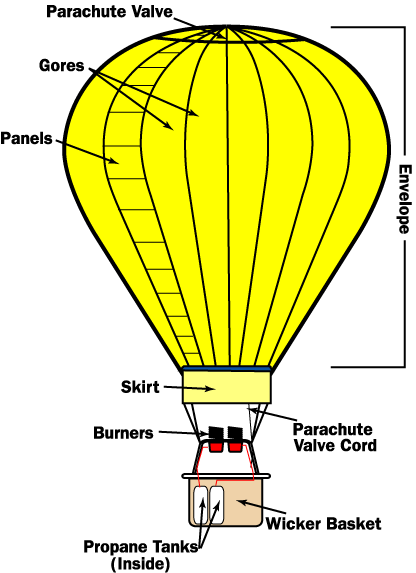nh1476@bristol.ac.uk
School of Chemistry
University of Bristol
Lighter than air
|
Chemists Montgolfier brothers Gas balloons Airships and blimps Modern hot air balloons Rozier balloons Special shapes |
Modern hot air balloons
Parts of a hot air balloon
|
Envelope
This is the colourful part of the balloon.
In modern balloons, it is made of reinforced heat-resistant nylon. It
is coated on the inside with a layer of polyurethane or silicon which
helps to retain heat and air. Between flights the envelope is folded and
rolled and stored in a bag around 1.5 metres in diameter. The envelope
is made up of panels between load tapes that run right through the envelope
and attach to the basket. The load tapes carry all the strain in the envelope
and the panels in between essentially just keep the air in. Hot air doesn't
escape from the bottom of the envelope as buoyancy keeps it moving up.
Parachute valve
At the crown of the balloon is a large hole
which is used to deflate the balloon on landing. Fortunately, during
flight, this hole is sealed by a parachute valve. held in place by the
pressure inside the balloon. The pilot can pull the parachute down out of
hole via pulleys using the parachute valve cord that drops down to the basket.
Parachute valve cord
This allows the pilot to pull out the parachute
valve to deflate the balloon.
Gores
These are panels of fabric cut at particulat angles which when sewn
together form the shape of the balloon.
Panels
These make up the gores.
Basket
This is where the passengers and pilot stand during flight. It also
contains the tanks of propane which are connected to the burners overhead.
Balloon baskets are generally still made from traditional woven willow
branches as no modern material gives the same combination of lightness,
strength and flexibility. Flexibility is especially important to absorb the
impact on landing and save the knees of the passengers. Very strong steel
cords pass through and underneath the basket and are attached to the load
tapes of the envelope. The basket may also contain instruments such as an
altimeter and a radio to aid the pilot in their flight.
Burner
The burner is fuelled by the propane tanks below and is usually
made of stainless steel. It is supported by plastic support poles that
fit into the basket and is also connected to the basket by way of steel
cords. Both the envelope and basket are attached to the burner frame
which must be strong.
Skirt
The very lowest part of the envelope is made from a flame resistant
material and serves to deflect any wind from the burner flame allowing
the flame to be directed staight up into the envelope. A scoop is a similar
piece of fabric which directs air up into the mouth of the balloon helping
the balloon to hold its shape.
Propane cylinders
These are located in the basket. The propane is highly compressed
in the cylinders and so when released flows quickly through the hoses
to the heating coil. On starting up the burner, the pilot will light a
pilot light which ignites the propane which is in liquid form to begin
with. As the flame burns, it heats up the metal in the surrounding tubing
which converts the propane to a gas. Propane as a gas is a more efficient
fuel and creates a stronger flame.
